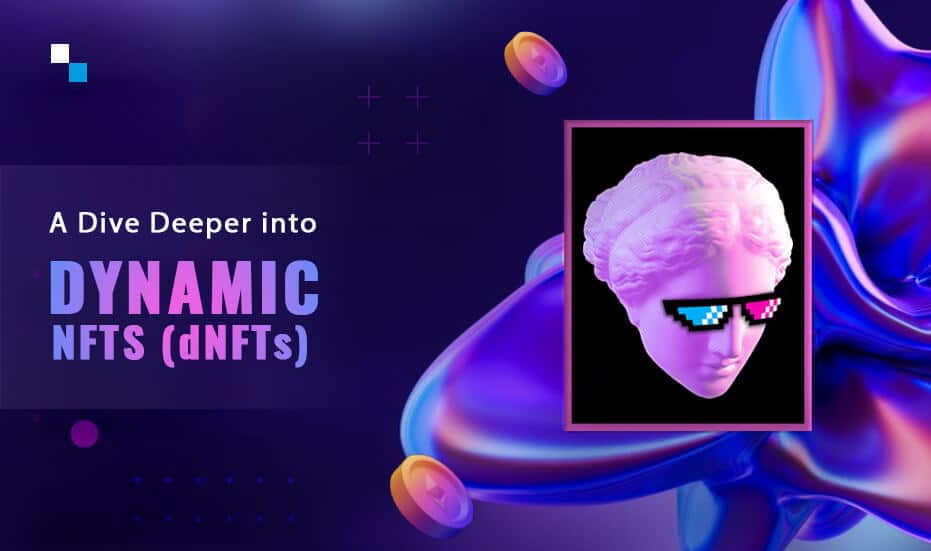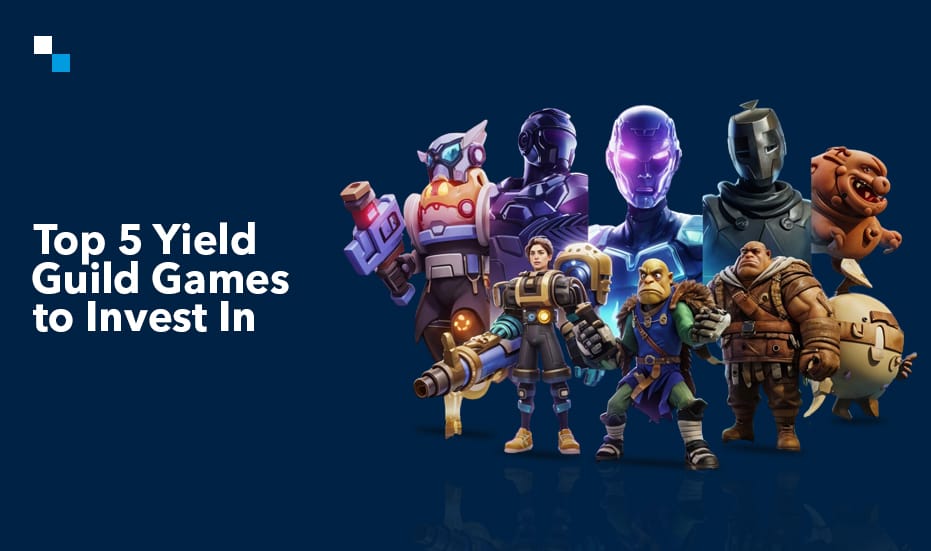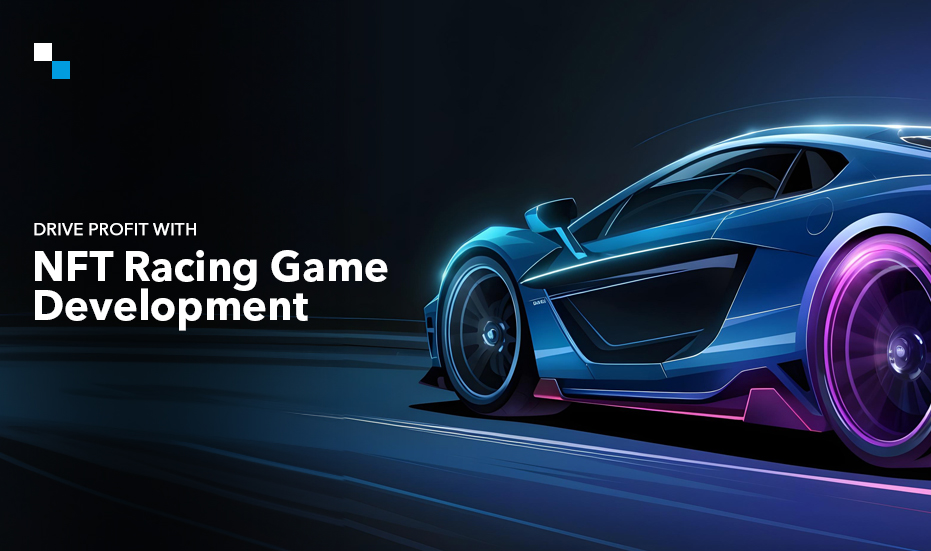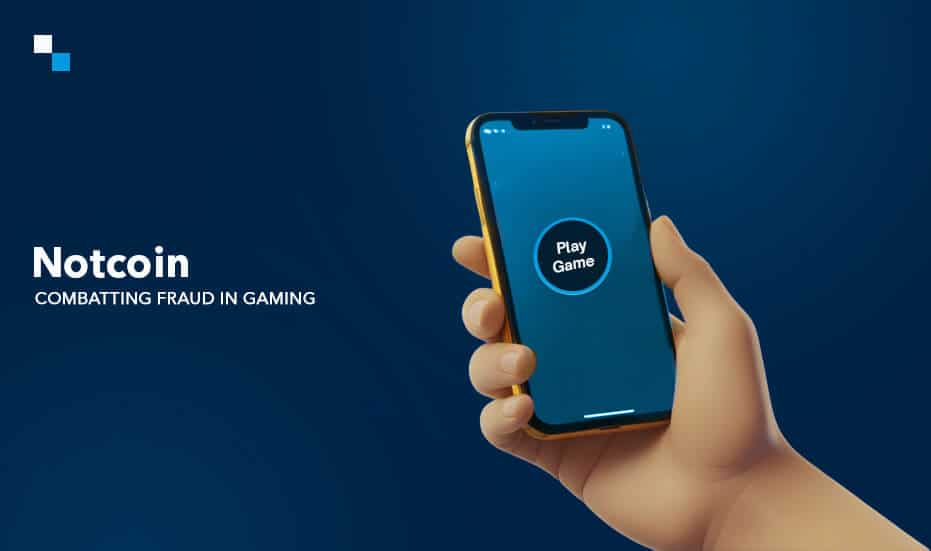With NFTs becoming mainstream across every major industry vertical across the globe, a new term is gaining the spotlight in the NFT space- Dynamic NFTs (dNFTs).
In this blog, we’ll be diving into this buzzword and learning how dNFTs are taking the NFT world to new heights.
Table of Contents
- What are Dynamic NFTs (dNFTs)?
- Dynamic NFT Examples
- Dynamic NFT vs Static NFT
- What are the Benefits of Dynamic NFTs?
- How Dynamic NFTs Work?
- How to Create Dynamic NFT?
- How to Create Dynamic NFT Using Chainlink Oracle?
- Potential Use Cases of Dynamic NFTs
- How Much Does it Cost to Develop Dynamic NFTs?
What are Dynamic NFTs (dNFTs)?
Also referred to as dNFTs, Dynamic NFTs are a new generation of non-fungible tokens that include programmable and interactive features, allowing the creation of digital items that can change and evolve over time. This opens up a wide range of new possibilities for NFTs, such as:
-
-
- Personalized experiences: Dynamic NFTs can be programmed to change based on the owner’s preferences, such as their location, the time of day, or their interaction with the NFT. This could allow for a more personalized and engaging experience for NFT owners.
- Evolving art: Dynamic NFTs can be programmed to change over time, such as by adding new features or by evolving the artwork itself. This could create a more dynamic and interesting piece of art that evolves as the owner interacts with it.
- Interactive games: Dynamic NFTs can be used to create interactive games, such as those that allow players to upgrade their NFTs or compete against each other. This could open up new possibilities for gaming on the blockchain.
-
Dynamic NFT Examples
Below are some real-life and best dynamic NFT examples that are taking the world by storm!
-
-
- LaMelo Ball NFTs: These NFTs track the performance of NBA player LaMelo Ball and change based on his stats. For example, if Ball scores a triple-double, the NFT will change to reflect that achievement.
- NBA Top Shot: This platform allows users to collect and trade dynamic NFTs of NBA highlights. The NFTs change based on the performance of the player in real life, such as by increasing in value if the player makes a game-winning shot.
- Gods Unchained: This blockchain-based trading card game uses dynamic NFTs. The NFTs can be upgraded over time, giving players a competitive advantage.
- The Sandbox: This virtual world allows users to create and own digital assets. These assets can be dynamic NFTs, which means that they can change over time based on the user’s actions.
- Async Art: This platform allows artists to create dynamic NFTs that can be changed and updated over time. This allows artists to create more interactive and engaging artworks.
- CryptoKitties: This is one of the first and most popular NFT projects. These are a form of digital cats which can be traded, bred, and collected. The cats have different attributes that can change over time, such as their fur color and pattern.
-
Dynamic NFT vs Static NFT
Let’s take a look at what is dynamic NFT vs static NFT!
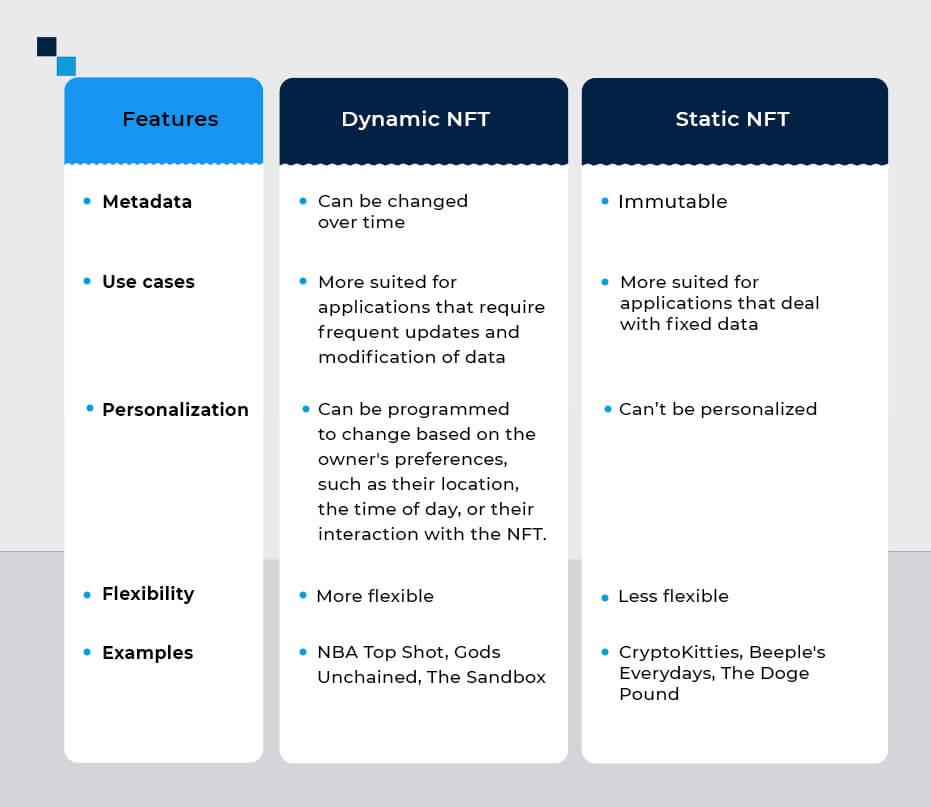
What are the Benefits of Dynamic NFTs?
Dynamic NFTs offer a number of potential benefits over static NFTs. They are more engaging, interactive, and secure, and they can be used for a wider range of use cases.
-
-
- Increased interactivity
Dynamic NFTs can be programmed to respond to user input, such as by changing their appearance or behavior. This can make them more engaging and interactive than static NFTs, which are simply digital representations of fixed assets. - New use cases
Dynamic NFTs can be used for a variety of new use cases that were not possible with static NFTs. For example, they could be used to create tickets that dynamically update to reflect the status of an event or to create in-game items that evolve as the player progresses. - Improved security
Dynamic NFTs can be programmed to include security features that make them more difficult to counterfeit. For example, they could be programmed to include a unique identifier that changes every time the NFT is transferred.
- Increased interactivity
-

-
-
- Enhanced transparency
Dynamic NFTs can be programmed to track their ownership and provenance. This can help to improve transparency in the NFT market, and can also make it easier to identify counterfeit NFTs.
- Enhanced transparency
-
How Dynamic NFTs Work?
Prior to understanding the working of dynamic NFTs, let’s understand the key components of dynamic NFTs.
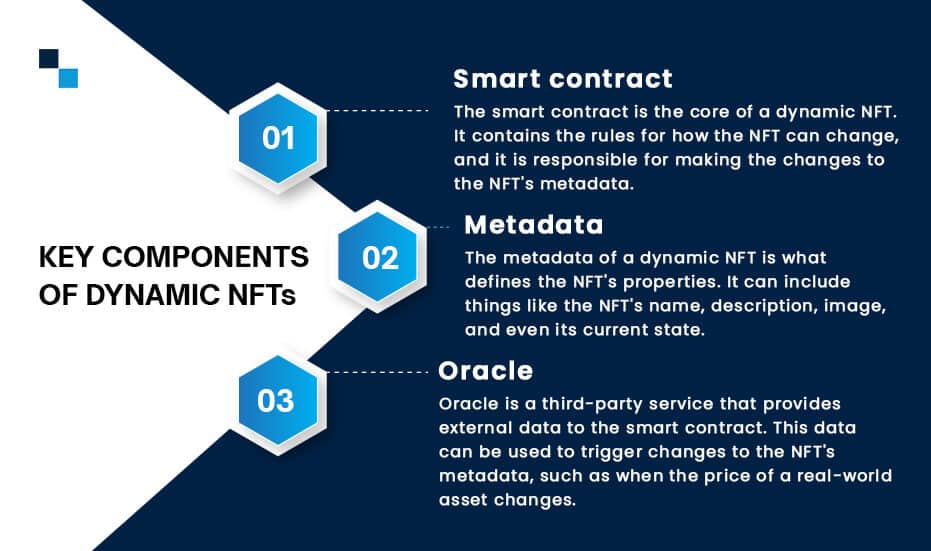
Here are the steps on how dynamic NFTs work:
-
-
- A dynamic NFT is created using a smart contract that includes a set of rules for how the NFT can change. These rules can be based on a variety of factors, such as the owner’s preferences, the time of day, or the performance of a real-world asset.
- The smart contract is then deployed to the blockchain, and the dynamic NFT is minted.
- Dynamic NFTs can further be purchased, sold, and traded similar to any other NFT.
- When the NFT changes, the smart contract is triggered, and the changes are made to the NFT’s metadata.
- The changes to the NFT’s metadata are then reflected on the blockchain.
-
How to Create Dynamic NFT?
There are a few different ways of creating dynamic NFTs. The first method is a dynamic NFT smart contract– using a smart contract that is programmed to update the metadata of the NFT based on certain conditions. For example, the metadata of an NFT could be updated to reflect the current price of a stock or the number of times a song has been played.
Another way how to make a dynamic NFT is to use a decentralized oracle. A decentralized oracle is a service that provides real-world data to smart contracts. This data can be used to update the metadata of an NFT, such as the location of a physical object or the weather conditions in a particular area.
Here are some of the tools that you can use on how to create a dynamic NFT:
-
-
- OpenZeppelin: OpenZeppelin is a library of open-source smart contracts that can be used to create dynamic NFTs.
- NFTPort: NFTPort is a platform that makes it easy to create and manage dynamic NFTs.
- Chainlink: Chainlink is a decentralized oracle network that can be used to provide real-world data to smart contracts.
-
Dynamic NFTs have a number of potential benefits while you build dynamic NFTs, including:
-
-
- They can be used to create more engaging and interactive NFT experiences.
- They can be used to create NFTs that are more responsive to real-world events.
- They can be used to create NFTs that have more utility.
-
However, there are also some potential challenges associated with dynamic NFTs, including:
-
-
- The complexity of creating and managing dynamic NFTs.
- The security risks associated with dynamic NFTs.
- The lack of standardization for dynamic NFTs.
-
How to Create Dynamic NFTs using Chainlink Oracle?
Here are the major steps on how to create a dynamic NFT using Chainlink Oracle:
-
-
- Choose a blockchain platform: There are a number of different blockchain platforms that support dynamic NFTs, such as Ethereum, Solana, and Cardano.
- Create a smart contract: The smart contract will be responsible for updating the metadata of the NFT.
- Deploy the smart contract: Once the smart contract is deployed, it will be accessible on the blockchain.
- Create the NFT: The NFT will be created using the smart contract.
- Configure the Chainlink oracle: The Chainlink oracle will be responsible for providing real-world data to the dynamic NFT smart contract.
- Update the metadata of the NFT: The metadata of the NFT can be updated by calling the smart contract.
-
Potential Use Cases of Dynamic NFTs
Here are some potential use cases of dynamic NFTs.
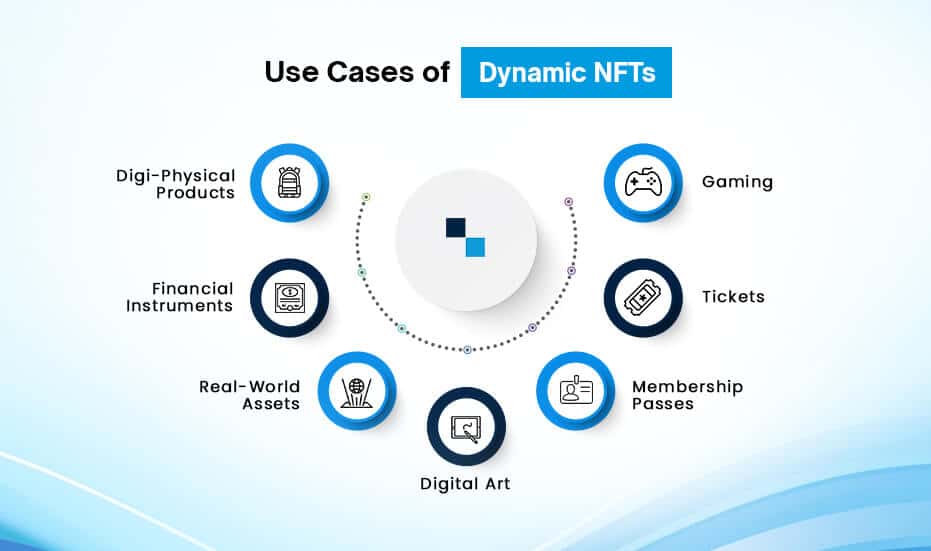
-
-
- Gaming
Dynamic NFTs can be used to create in-game items that evolve as the player progresses. For example, a sword in a video game could be programmed to increase in power as the player defeats more enemies. - Tickets
Dynamic NFTs can be used to create tickets that dynamically update to reflect the status of an event. For example, a ticket for a concert could be programmed to change its appearance to reflect the artist’s current setlist. - Membership passes
Dynamic NFTs can be used to create membership passes that dynamically update to reflect the holder’s privileges. For example, a membership pass to a club could be programmed to grant access to exclusive events or discounts. - Digital art
Dynamic NFTs can be used to create digital art that changes or evolves over time. For example, a painting could be programmed to change its colors or patterns based on the time of day or the viewer’s location. - Real-world assets
Dynamic NFTs can be used to represent real-world assets, such as property or vehicles. The metadata of the NFT could be updated to reflect changes in the asset’s value or ownership. - Financial instruments
Dynamic NFTs can be used to create financial instruments that dynamically update to reflect changes in the market. For example, an NFT could be programmed to represent a share of a company, and the metadata of the NFT could be updated to reflect the company’s stock price. - Digi-physical products
Dynamic NFTs can be used to represent digi-physical products, such as clothing or accessories. The metadata of the NFT could be updated to reflect the product’s condition or location.
- Gaming
-
How Much Does it Cost to Develop Dynamic NFTs?
Here is a more detailed breakdown of the factors that can affect the cost of developing dynamic NFTs:
-
-
- Complexity of the NFT: The complexity of the NFT is one of the biggest factors that will affect the cost. If the NFT is simple, such as a ticket that changes its appearance to reflect the artist’s current setlist, then the cost will be relatively low. However, if the NFT is more complex, such as a sword in a video game that increases in power as the player defeats more enemies, then the cost will be higher.
- Features of the NFT: The features of the NFT will also affect the cost. For example, if the NFT stores a lot of data, or if the data is updated frequently, then the cost will be higher.
- Blockchain platform: The blockchain platform that is used to create the NFT will also affect the cost. Some blockchain platforms, such as Ethereum, are more expensive than others.
- Developer’s fees: The fees charged by the developer will also affect the cost. Some developers charge more than others, so it is important to shop around.
-
Final Thoughts
Dynamic NFTs are a relatively new technology, but they have the potential to revolutionize the NFT space. As the technology continues to develop, it is likely that we will see even more innovative and exciting applications for dynamic NFTs.
Businesses can implement dynamic NFT smart contracts that are programmed to update the metadata of the NFT based on certain conditions. This will accompany multiple benefits for businesses in the long run such as creating more engaging and interactive experiences for customers, new revenue streams, and improving customer loyalty.
Become an early adopter of dynamic NFTs while you partner with Antier and gain a competitive edge in the global market. Book a free consultation now.
